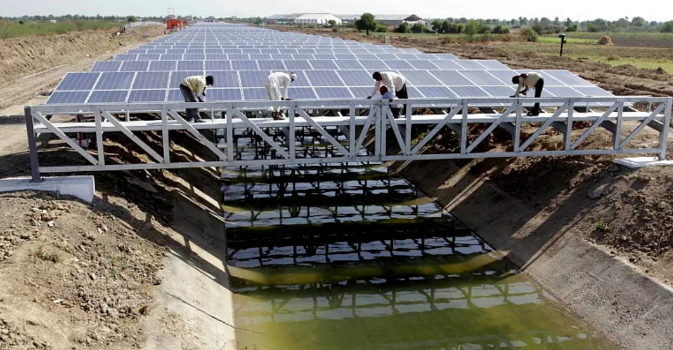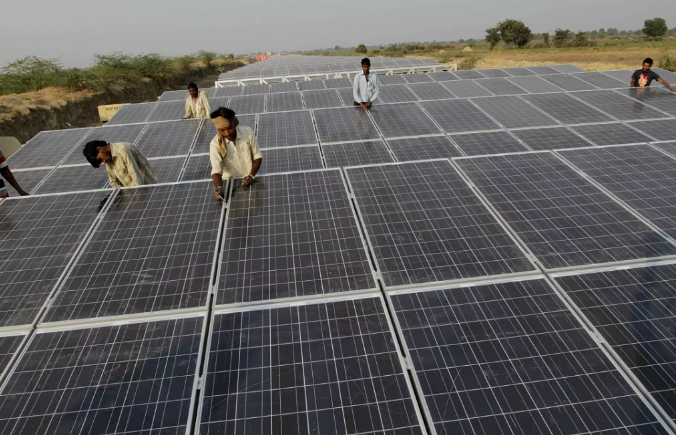
- English
- Español
- Português
- русский
- Français
- 日本語
- Deutsch
- tiếng Việt
- Italiano
- Nederlands
- ภาษาไทย
- Polski
- 한국어
- Svenska
- magyar
- Malay
- বাংলা ভাষার
- Dansk
- Suomi
- हिन्दी
- Pilipino
- Türkçe
- Gaeilge
- العربية
- Indonesia
- Norsk
- تمل
- český
- ελληνικά
- український
- Javanese
- فارسی
- தமிழ்
- తెలుగు
- नेपाली
- Burmese
- български
- ລາວ
- Latine
- Қазақша
- Euskal
- Azərbaycan
- Slovenský jazyk
- Македонски
- Lietuvos
- Eesti Keel
- Română
- Slovenski
- मराठी
- Srpski језик
A new concept of photovoltaics, photovoltaics on the canal!
2023-07-31
At the semi-annual meeting of the China Photovoltaic Industry Association, Wang Bohua, honorary chairman of the association, pointed out that my country's photovoltaic and transportation fields are integrated and developed, with wide and long roads, and the future can be expected. As mentioned before, the Germans are already laying photovoltaic modules on railroad tracks.
Now, it's time to install photovoltaics on the canal.

01 A good way to prevent the canal from evaporating
Installing photovoltaic modules on artificial canals seems effortless, but why do we rarely see it?
A study shows that if all the canals in California are covered with photovoltaic modules, the power generation can basically meet the annual electricity demand of the super city of Los Angeles. What's more, it will also effectively reduce the evaporation of the river.
As early as 2015, California had suffered from a four-year drought. Then-Governor Jerry Brown ordered an unprecedented 25% reduction in water use per household. In this case, the farmers who use the most water are also forced to reduce irrigation. At the time, Brown also set a goal for the state to source half its energy from renewable sources in the face of climate change.
Yet when entrepreneurs Jordan Harris and Robin Raj came to their door with a solution to evaporative water loss and climate pollution — solar panels on irrigation ditches — there was no People agree with their ideas.
Eight years later, as humanity faces devastating heat, record-setting wildfires, the looming drought crisis on the Colorado River, and a growing commitment to address climate change, the two advocates' company, Solar AquaGrid, revisits the past . The first canal power generation project covered by photovoltaic modules in the United States will break ground.
The idea is actually quite simple: Install solar panels on canals in sunny, water-scarce regions to reduce evaporation and generate electricity.
A study by the University of California, Merced further supports this idea - covering 6,437 kilometers of canals in California with solar panels can save 63 billion gallons of water evaporation every year, and the solar panels will also generate 13 gigawatts electricity. This amount of power generation can basically meet most of the electricity demand of the entire city of Los Angeles. Of course, this is only a hypothesis, and these data have yet to be tested.
The Nexus project in California's Central Valley will change that.

In the US state of California, canal solar energy has long been regarded as the best place to experiment, because California has a good economic foundation, many canals, and relatively scarce water resources.
Solar AquaGrid believes that only the research of well-known institutions can promote the implementation of this idea, and provided funding for the University of California, Merced to study the impact of the California solar-covered canal project.
Around the same time, Turlock Irrigation District (a company that also provided electricity) contacted UC Merced. The company hopes to build a solar project to support the state's goal of 100 percent renewable energy by 2045. But land in California is expensive, so building on existing infrastructure is attractive.
California committed $20 million in public funding to turn the pilot into a tripartite partnership between the private, public and academic sectors. The canal, about 2.6 kilometers long and 20 to 110 feet wide, will be covered with solar panels and will be about 5 to 15 feet above the water.
In addition, the shading of the panels may reduce the growth of weeds in the canals. The utility spends $1 million a year to get rid of the weeds.
02 Modi's canal photovoltaic is now bankrupt

Canal PV in California, USA, is by no means the first of its kind.
India has spearheaded the world's largest irrigation PV project. The Sardar Sarovar Dam and Canal Project supplies water to hundreds of thousands of villages in the arid region of the western Indian state of Gujarat.
Narendra Modi, then Chief Minister of Gujarat and now Prime Minister of India, inaugurated the project in 2012. Engineering firm Sun Edison has pledged to build 19,000 kilometers of solar-powered canals. But not long after the project launched, the company actually filed for bankruptcy.
“The investment cost is really high and maintenance is also an issue,” says Jaydip Parmar, a Gujarat engineer who oversees several small solar canal projects.
He said that since there are a large number of high-sunlight and dry areas in India where photovoltaics can be installed, ground-mounted solar energy is far more economical than installation on canals.
The bulky design is another reason why the technology has not been widely adopted in India. The photovoltaic modules in the Gujarat pilot project are located directly above the canal, which limits the routine maintenance of the canal and the access of staff in case of emergency.
Americans have taken note of India's painful lessons, and the California canal photovoltaic project will use better materials and will be higher from the water.
Additionally, the Gila River Indian Tribe in the United States has received funding to install solar energy on its canals to conserve water and relieve pressure on the Colorado River. The Salt River Project, one of Arizona's largest hydroelectric utilities, is working with Arizona State University on the technology.
Rep. Jared Hoffman, D-Calif., who has been talking about the technology for nearly a decade, thinks there is far more interest in building taller dams than canal photovoltaics.
He allocated $25 million through last year's Inflation Reduction Act to fund a pilot project for the Bureau of Reclamation, whose site selection is currently being evaluated.
More than 100 climate advocacy groups, including the Center for Biodiversity and Greenpeace, have now written to Interior Secretary Deb Harland urging them to "accelerate the widespread deployment of photovoltaics above the canal".
The United States' current 8,000 miles of canals could generate more than 25 gigawatts of renewable energy—enough to power nearly 20 million homes and prevent tens of billions of gallons of water from evaporating.



